Things to do in Split
Split is an ancient and attractive city with centuries of history bolstering its modern appeal. As with many Croatian settlements, the richest concentration of tourist attractions in Split can be found in its oldest districts around the famous Diocletian's Palace. This magnificent building was constructed by the Roman Emperor Diocletian in 303 AD, and it's a privilege and a pleasure to explore. There are several informative walking tours through the palace complex and surrounding old areas.
The impressive Cathedral of St Domnius and a climb up its rather scary bell tower will often feature on these tours. Another experience not to be missed is the remarkable clock by West Gate, which has kept time in the city for more than a century.
There are lots of other things to see and do in Split, such as the oldest museum in Croatia: the Archaeological Museum. It collects and displays artefacts from the city's long history and is a joy for history buffs. On a more contemporary note, travellers will enjoy a stroll along the pretty promenade of Riva Harbour, lined with bars and spots for outside recreation.
Split is also a convenient base for excursions and day trips to myriad beautiful islands and villages: the nearby islands of Brac and Hvar offer stunning beaches and charming little towns, and the coastal villages of Makarska and Sibenik are enduring Croatian favourites. Lastly, the magical walled town of Trogir, a UNESCO World Heritage Site, is situated on a tiny island between Ciovo and the mainland, and tops the list of many a Croatian travel itinerary.
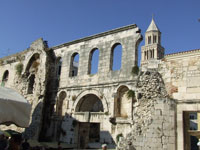
Diocletian's Palace
Diocletian's Palace is one of the world's most imposing ancient Roman structures. Built between the late third and early fourth centuries A.D., it is more than a palace or a museum…
Diocletian's Palace
Diocletian's Palace is one of the world's most imposing ancient Roman structures. Built between the late third and early fourth centuries A.D., it is more than a palace or a museum. Rather, it is Split's living heart, where visitors will find the labyrinthine streets packed with people, bars, shops and restaurants. The palace was constructed as a combined imperial residence, military fortress and fortified town, and its original structure has been added to continuously over the millennia.
The Roman emperor, Diocletian, commisssioned the palace to be finished in time for his retirement in A.D. 305, sparing no expense in its construction. Over the course of 10 years he transported lustrous white stone from the island of Brac, marble from Italy and Greece, and also columns and 12 sphinxes from Egypt for the sake of his project.
These days, visitors can often hear music in the palace and should note that the setting is particularly attractive in the evenings. When the sun sets, the marble and granite columns are usually illuminated by colourful garlands, and the palace's interiors become stages for actors in Roman togas.
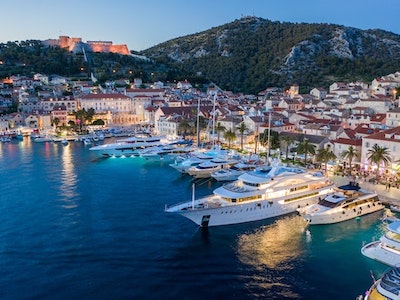
Hvar Island
The island of Hvar lies off the coast of Split and abounds with Romanesque and Renaissance buildings, and a true Mediterranean atmosphere. Inhabited since 3500 BC, it's now mainly …
Hvar Island
The island of Hvar lies off the coast of Split and abounds with Romanesque and Renaissance buildings, and a true Mediterranean atmosphere. Inhabited since 3500 BC, it's now mainly a wine-growing area, with the main towns of Vrboska and Jelsa famed for their Dalmatian vintages. Hvar is dotted with picturesque rural villages, many fairly untouched by time and tourism. The incredible Hvar Fortress is one of the island's must-see attractions. Reached by a fairly strenuous climb, it offers exquisite views of the whole town and harbour. No trip to Hvar would be complete without a visit to Dubovica Beach, which is often delightfully free of crowds.
Website www.hvar.hr
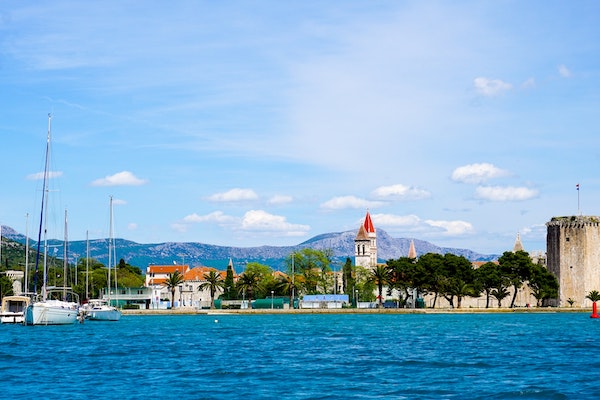
Trogir
The gorgeous historic town of Trogir is one of Split's most essential day trips. Set within medieval walls and connected to both the mainland and the island of Čiovo by bridges, t…
Trogir
The gorgeous historic town of Trogir is one of Split's most essential day trips. Set within medieval walls and connected to both the mainland and the island of Čiovo by bridges, this tiny island has retained many intact and beautiful buildings from its golden age between the 13th and 15th centuries. Today, it is a treasure trove of Renaissance and Baroque architecture, and Romanesque churches, and has deservedly been on the UNESCO list of World Heritage Sites since 1987. Summer nights are perfect for soaking up Trogir's laidback atmosphere, as everyone heads for the bars and cafes that line the wide seaside promenade.
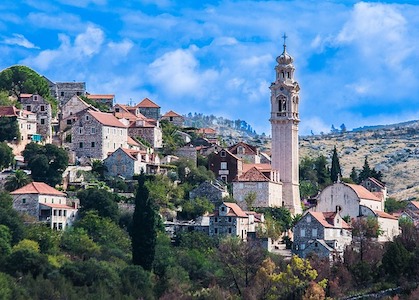
Brac Island
Bol and Supetar are the two main resorts on Brac, and have attractive old towns and laid-back charm. Brac is a great destination for a number of watersports, with Bol being the win…
Brac Island
Bol and Supetar are the two main resorts on Brac, and have attractive old towns and laid-back charm. Brac is a great destination for a number of watersports, with Bol being the windsurfing capital of Croatia. It also boasts a famous strip of beach that stretches out into the ocean, featuring on most Croatian tourist brochures. Like much of Croatia, the beaches on Brac Island are mainly rocky, boasting stunningly clear blue water and calm seas. Those desperate to find a sandy beach should head down to Lovrecina, which has its own beach bar and restaurant. Brac is generally less crowded than Split and other popular areas on Croatia's mainland, but can get busy during the peak summer months.
Website www.bracinfo.com
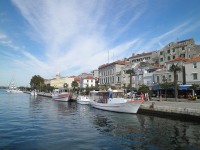
Sibenik
Sibenik is a historic town in central Dalmatia. Over the centuries, it has endured many rulers who have claimed it as their own, from Byzantium to the Kingdom of Bosnia. Naturally,…
Sibenik
Sibenik is a historic town in central Dalmatia. Over the centuries, it has endured many rulers who have claimed it as their own, from Byzantium to the Kingdom of Bosnia. Naturally, it's a product of this complex past, with a diverse tapestry of influences and rich cultural heritage. Sibenik is home to the Cathedral of St Jacob, the crowning glory of the Dalmatian Coast. The beautiful baptistery, domed roof and 71 stone heads on the exterior walls truly make this Renaissance cathedral a thing of divine beauty. The city also makes a good base from which to visit the nearby Krka National Park.
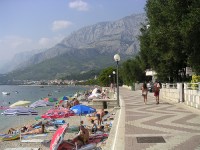
Makarska
Fringed by the two green peninsulas of Osejava and St Peter, Makarska's cobblestoned streets and natural harbour nestle in the shadow of Mount Biokovo. This beautiful town offers s…
Makarska
Fringed by the two green peninsulas of Osejava and St Peter, Makarska's cobblestoned streets and natural harbour nestle in the shadow of Mount Biokovo. This beautiful town offers secluded beaches washed by an azure sea and lies at the heart of the Makarska Riviera, which is characterised by pine forests and a string of white pebble beaches. Makarska's history has included occupations by the Venetians, Turks, French and Austrians, who all left imprints of their own culture and tradition. The town boasts a 16th century Franciscan monastery, a Venetian fountain, several churches and Baroque palaces. The main tourist district is lined with fashionable boutiques, cafes and bars, all a stone's throw away from the yachts and catamarans docked in the harbour.



